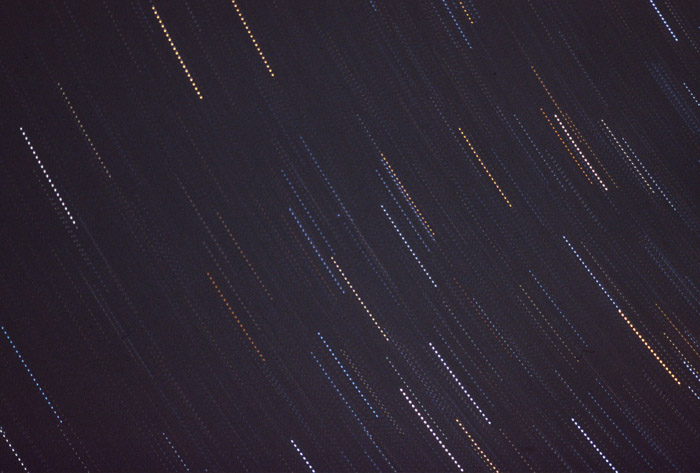[Reconstructed after software failure]
So, I didn’t go out to shoot anything new to kick off the International Year of Astronomy like I should’ve, when we had nice clear skies (but cold, of course). So instead, I’ll post a curious photo and ask for comments.
The pic above was taken in 2007, my best guess is August 13th or 14th, round about midnight EDT. I had set up my EOS 3 with the intervalometer to do a multiple exposure of the night sky. Unfortunately, since this was just an experiment, I didn’t write anything down, so the specs I’m about to provide are in question, and if you have reason not to believe them, then go with your instincts.
Anyway, I believe I ran a series of exposures of 8 or 10 seconds each, 45 seconds apart. I was aimed nearly straight up, and shooting with my 24-135mm lens at, most likely, 24mm (since the zoom would have crept down to that setting anyway with being aimed upwards), which would give this frame a (roughly) 72 degree field of view along the long side. There’s a chance I used the 105mm macro (19 degrees), but doubtful – I think I was using that on another body at the same time. The film is Fuji Provia 100F slide film, because, hey, nothing else brings out the star colors half as well. My position was roughly Lat 36.020° N, Lon 79.131° W.
While am I going into all this? Because, right dead center of the frame, is something I don’t think should be there. Look for the blue dot that’s a little brighter, and extended off the tip of, a trail in the middle of the frame. You can click on the pic above to see the larger version, and I can provide a full-frame scan upon request of anyone who really wants to play around.
No, it’s not an extension of the trail it’s near, with the separation occurring because of clouds – there were none that night. No, it’s not a plane or satellite, since both would have left trails at that exposure length. Same goes for a meteor (and yes, this was during the Perseids storm), unless it came right straight down towards the camera.
So, any ideas? I toyed with the idea of it being a rare visible Gamma Ray Burst, but there’s no record of one occurring during that timeframe. And nothing else has come to mind.
Now, I have no idea what constellation or area of the sky this is in – I honestly do not recall where I was aiming, and perusing sky charts for that time has not yielded any matches yet. Oh, yeah, I should probably mention that I did a Photoshop trick on another version, filtering out all but the end point of each trail to produce a proper starfield. If you download that pic, please keep in mind that I have no idea when that stray dot occurred during the series of exposures, so its position could be anywhere along a diagonal line stretching down and to the right of where it’s marked. In other words, I choose one out of 21 different positions to plot the individual stars, but do not know when the stray dot appeared during those 21 exposures, so don’t consider it accurate in relation to the other stars.
It’s even possible it’s a booger in the film emulsion, but it seems like a stretch to have one that’s the same size, shape, and just a little brighter than the objects in the rest of the frame.
Let me know what you think!
[The following portion added on June 13, 2009]
I stumbled on another possibility that I’m favoring right now: I caught a geostationary satellite. A long exposure posted on, I think, the Earth Science Picture of the Day site (whose archives are unavailable as I type this) showed several points of light among the streaks of an extremely long star exposure, identified as geostationary satellites. They would in the same area of sky no matter what the time or season, hence the name. Internally, I argued that the lateness of the hour when I took the photo would have precluded any satellites being illuminated by the sun, but geosats are way the hell out there, intended to link as much of the globe as possible, so they stand a good chance of being constantly illuminated. Their distance would also make them faint, but my photo is, essentially, 21 exposures, and for something stationary that would mean they’d all pile atop one another to add to the exposure of that point.
Anyone who can shed some light on this (oh my, I’m such a card) is welcome to chime in.





















































